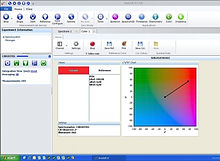
t. +44 (0) 1353 722558
AvaSoft-COLOUR
Colour Application add-on Software

For online and offline reflective colour measurements, AvaSoft-COLOUR is the ideal companion.
This application provides a precise way to perform colour measurements using the basic principles and techniques defined by the International Commission on Illumination (CIE), so that CIE 1976 L*a*b* colour parameters can be calculated, along with other parameters such as Hue, Chroma and X, Y, Z.
These parameters can be displayed in a CIELAB chart or in a graph versus time. Another possibility is to save the measured L*a*b* values to a database to be recalled in for future measurements as reference colours . Colour differences (ΔELab, ΔL*, Δa*, or Δb*) are carried out by comparing the measured L*a*b* values to the stored database values.
The colour of an object can be expressed by the CIE 1976 (L*a*b*) colour space. L* describes the brightness of the colour. A positive value of a* describes the redness of the colour, a negative a* describes the greenness. Similarly, yellowness is a positive b*, where blue is a negative b*. The L*a*b* values are derived from the CIE tristimulus values X, Y and Z of the sample (object) and the standard illuminant tristimulus values Xn, Yn and Zn.
The standard illuminant tristimulus values for Xn, Yn, and Zn are constant and depend only on the type of standard illuminant that has been chosen.
The CIE tristimulus values X, Y and Z of the colour of an object are obtained by multiplying the relative power P of a standard illuminant, the reflectance R (or the transmittance) of the object, and the 1931 or 1964 CIE standard observer functions xn, yn and zn (2 and 10 degree angles). The integral of these products over all the wavelengths in the visible spectrum (380 to 780nm with a 5nm interval) gives the tristimulus values.
Colour chart
The colour chart display features:
-
Display in CIELAB chart, the actual sample colour as well as the reference colour with the corresponding ΔELab, ΔL*, Δa*, or Δb* values are displayed and saved as well.
-
The settings for the LAB chart display can be changed, such as no graphical display of reference and sample colour in order to speed up the measurements.
-
The standard observer angle is selectable for 2° or 10°.
-
The reference colour can be saved to and loaded from a colour database. The database contains, apart from all colour parameters, a product ID and a display of the actual colour. The database can be sorted alphabetically or in either value column.
Time series
The time series display has following features:
-
Display in time series can be selected for any number of channels.
-
For each channel, a colour parameter (L*, a*, b*, hue, C, X, Y, Z, ΔELab, ΔL*, Δa*, or Δb*) can be selected. For each channel a different reference colour can be selected, enabling colour sorting.
-
For each channel, the time axis can be set to a different scale, allowing simultaneous display of long term and short term monitoring of the same parameter.
-
For each channel, the actual measured colour, as well as the reference colour (if in ΔELab, ΔL*, Δa*, or Δb* mode) is displayed.
-
The saved time series data can be displayed with extensive zooming and dragging options.
